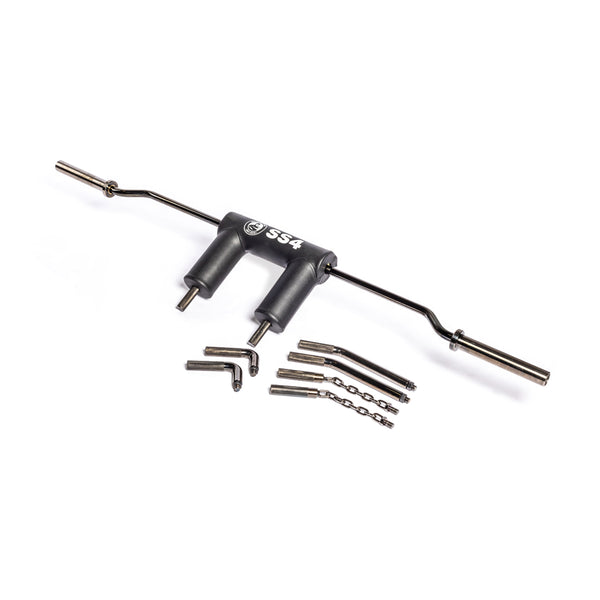People can perform squats in various ways, each of which has different benefits. A barbell squat is one of the primary compound exercises that target the legs, lower back, and core muscles. It helps strengthen not only your muscles but also your joints and burns more calories. While it’s a great leg builder, it can also boost your powerlifting performance in many ways.
Aside from the target muscle groups, the barbell squat also requires ankle and core stability. Shoulder mobility and trap activation are important to keep the barbell under control. This article covers basic techniques on how to do a proper barbell squat if you're just starting with your powerlifting training.
Here’s how to do a proper barbell squat with the right form:
- Get into position and narrow your stance. Place your feet shoulder-width apart and turn your toes at about 45° angle.
- Pull the bar and bend it across your back. Bring your elbows together, tuck your chin, and knees forward.
- Squat down until your hips are lower than your knees.
- Squat back up while keeping your knees out and chest up.
- Stand with your hips with knees locked and squeeze your glutes - keep that lateral pressure out on the floor.
- Hold the weight, then take a big breath, hold it and squat your next rep.
Now, we’ll look at the steps and techniques in more detail. Before you get under the bar, you must first find your hand position. Wrap your thumbs around the bar and engage your wrists. Try to actively flex your wrist by engaging your forearm and moving your palm in the direction of your face to reduce pressure on your joints.
Lowering the elbows brings them to better alignment with the trunk, eliminates shoulder overextension, and places the forearms in compression. To achieve the proper position for your barbell squat, you'll have to determine where the bar sits on your back. Take the bar out of the rack with it resting on your rear shoulder muscles.
The bar should be positioned right at the base of the neck across the top of your traps. It is important to first squeeze your shoulder blades together to create a pillow for the bar to sit on, to make it feel more comfortable. Make sure you do this before you set the bar across your back with your feet roughly shoulder-width apart, toes pointing slightly out.
A common mistake among beginners is the squat walkout. When you step out of the rack, you don’t want to be too near or close to the rack. The squat walkout is your setup and creates the foundation for your barbell squat which needs to be done efficiently and with confidence. The heavier the weight gets, you will want to minimize the number of steps you’re taking.
One or two steps backwards is enough to do a proper barbell squat. Where the head goes, the torso will follow. So the last thing you want to do is look up when you squat. Your chin should remain tucked throughout the movement, look forward, and keep that gaze constant during the squat. The safest position for your neck is always to keep it neutral like when you stand.
A hip hinge is essential in a barbell squat, so we need to make sure we execute this properly for maximum movement efficiency. Simply make a "hinge" by moving your hips backward without having the low back flex along with it. Your upper body should naturally lean forward, as your butt goes back, and maintain a neutral spine position as you go down. Before squatting downward, draw your attention to your big toe, pinky toe, and heel.
Once you feel the load evenly distributed over these contact points, claw your toes into the ground. Grip the floor with your feet to create a stable foot position. Look down and picture you're standing on a paper towel under the balls of your feet and imagine that you're trying to rip the paper towel in half with lateral pressure. Breathing and bracing your core is a key component of feeling strong from the moment you un-rack the bar to the point of lockout.
In a barbell squat, breathing should start with an inhale before you un-rack the weight, followed by holding your brace as you step back and a slight exhale as the bar settles on your back. One of the biggest common faults that we see in barbell squats is the chest collapsing forward. Drive your elbows down and back to engage the lats, give a larger shelf for the barbell, and create additional stability in the trunk. This improves rep quality and decreases the risk of injuries. You’ll always want to squat with your heels on the ground.
If you start coming forward onto your toes, you will lose your balance forward. Once at the bottom and when it's time to stand back up from your squat, keep everything tight and drive through your heels (the same way you did on the way down). If your heels are coming up, you’ll reduce the amount of force being transferred to the floor as you push the barbell upward. Squeeze your butt at the top and make sure you're using your glutes.
A proper barbell squat might be an intimidating lift for beginners because there are several considerations to keep in mind to execute it safely and efficiently, so here are some top tips to improve your barbell squats.
- Maintain heel pressure and pick those big toes up
- Start the squat from your hips and knees
- Pre-exhaust your quads
- Anchoring the hips




